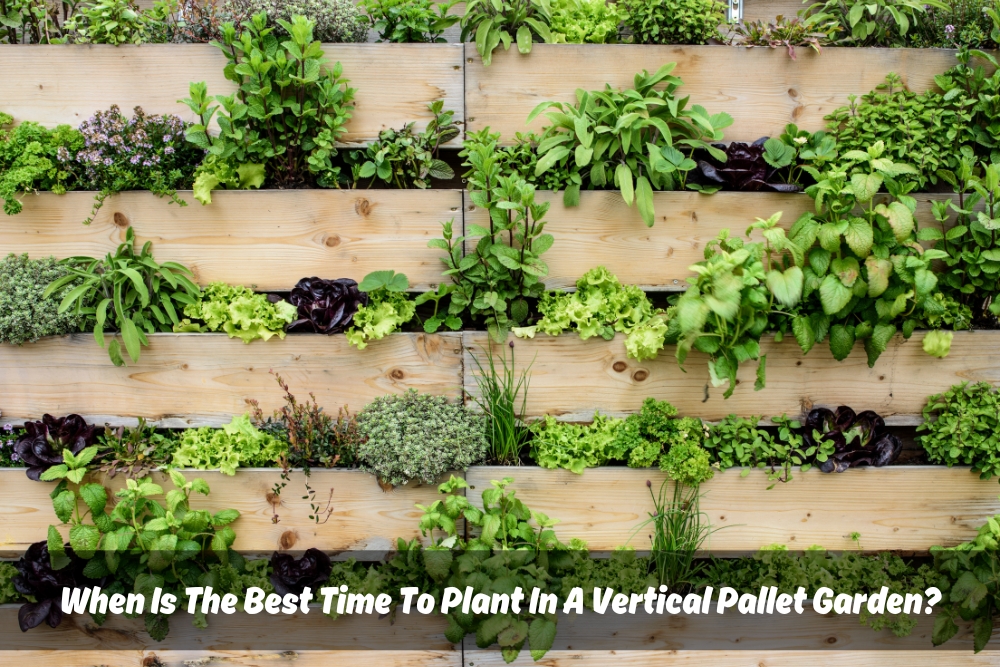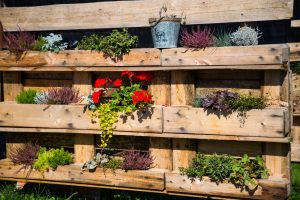A vertical pallet garden is the coolest way to add a splash of life to your balcony, courtyard, or even indoors. But with all the sunshine, soil, and seed options, you might be wondering when exactly to get your green thumb on.
This guide will be your secret weapon for navigating planting times in your vertical paradise. It’ll cover seasons, climate zones, what you want to grow, and even how to get a head start indoors.
Is there a secret season for planting success in a vertical garden?
While there isn’t a magic “best time” to plant everything, there are a few key things to consider:
- Your climate: Sydney’s weather is pretty cruisy compared to other parts of Australia – summers can get hot, winters are chill, but nothing too wild. This means you’ve got more wiggle room with planting times than folks in super hot or cold areas. But just like your favourite coffee, Sydney has seasons: spring and autumn are comfy for most plants, while summer cranks up the heat.
- Plant pals: Every plant has its favourite temperature range for growing big and strong.
- Seeds or seedlings: Seeds take more time and care than ready-made seedlings you can buy.
Should you consider seasons when planting in a vertical pallet garden?
Seasons definitely play a role in planting times for your vertical haven. Here’s a quick cheat sheet:
- Spring (September to November): Generally the rockstar planting time across most of Australia. The days are warming up, frost risks are fading, and there’s plenty of sunshine to fuel growth.
- Summer (December to February): It’s party time for plants that love the sun like chillies, basil, and eggplants. Especially if you’re down south where it gets scorchingly hot. Just remember, all that sunshine means they get parched easily, so drainage is key in your vertical garden!
- Autumn (March to May): Time to ditch the summer crew! Swap out your heat-loving plants for cooler weather fans like lettuce, spinach, and beetroot. This is especially true in the southern states where things stay a little more mellow for a longer stretch. Think cosy sweaters for your plants!
- Winter (June to August): Planting options can be a bit limited in winter, especially in colder regions. But some hardier herbs like parsley and thyme might do well in a sheltered spot.
Plant selection and planting time for your vertical pallet garden
The key to a thriving vertical pallet garden is choosing plants that love the same climate as you! Here’s a cheat sheet to get you started, based on temperature preferences:
- Cool crew (5-20°C):
- Leafy delights: Lettuce, spinach, beetroot, silverbeet, kale, cabbage.
- Herb haven: Parsley, coriander (cilantro).
- Warm weather warriors (20-30°C):
-
- Veggie bonanza: Tomatoes, eggplants, capsicums (peppers), beans, cucumbers, melons.
- Herb hero: Basil
Not only will these plants thrive in Sydney’s climate, but opting for Australian native plants for landscaping can also attract beautiful native pollinators to your vertical oasis! These plants are well-suited to vertical gardens and come in a variety of colours, shapes, and sizes.
Starting seeds indoors before planting in your vertical pallet garden
Want to get a head start on the season? You can totally sow seeds indoors for your vertical garden! This is a great hack for cool-weather crops or those that are a bit slow on the sprout. Here’s how to do it like a pro (well, almost):
- Seed selection and seedling homes: Pick your seeds and find some sunny spots indoors. Use well-draining seed trays or pots.
- Sprouting the squad: Those seed packets are your secret weapon! They’ll tell you exactly how deep to plant your tiny friends and how much space to give them to grow big and strong.
- Moisture and warmth: Think a damp towel, not a swamp! You want the soil to be moist but not drowning. A gentle watering can or spray bottle is your best friend here. To give your seedlings a warm hug, a sunny windowsill or even a heat mat (like a tiny blanket!) can work wonders.
- Moving out: Once your little plant babies have a few sets of proper leaves (not the first tiny ones they sprout), it’s time to get them used to the big world. This is called hardening off. Basically, you gradually introduce them to the elements outdoors for a week or so before they officially move into your vertical garden.
Maintaining your vertical pallet garden after planting
Once your vertical haven is flourishing, proper care is key. Here are some top tips:
- Watering: Don’t let your plant pals get parched! Especially when the sun’s beating down, give your vertical garden a good drink. You want the soil to be like a damp sponge – not soggy, but not dry as a desert either. Here’s a trick: stick your finger in the soil. If it feels dry after reaching the first knuckle (about an inch), your plants are thirsty!
- Feeding time: Use a liquid fertiliser suitable for your chosen plants according to the package instructions. Generally, cool-season plants need less fertiliser than their warm-season counterparts. Opt for organic fertilisers whenever possible to nourish your plants and protect the environment.
- Sunshine savvy: Most plants are like sunbathers, needing good light to grow strong and healthy. But don’t worry, some are a little more shade-tolerant, like lettuce and spinach. These leafy friends might even appreciate a break from the midday sun’s heat. Just remember, check the light needs of your chosen plant crew and move them around your vertical garden jungle gym to find their happy spot.
- Weed patrol: Nobody likes gatecrashers, especially in your garden! Weeds love to steal water and nutrients from your plants, so keeping them in check is important. You can be a weeding warrior and hand-pull these invaders, or use a gentle, organic herbicide specifically made for container gardens (like your vertical paradise!).
- Mulch magic: Think of mulch as a tiny superhero cape for your plants! A layer of organic mulch around the base of your plant buddies helps them in a few ways. It keeps the soil moist, stops weeds from taking over, and even helps regulate the soil temperature. For mulch, picture things like pea straw, lucerne, or bark chips – comfy and cool for your plant crew!
- Snip, snip: Regularly harvest your bounty! This encourages new growth and keeps your plants looking their best.
Final thoughts
Planting your vertical garden is a rewarding journey, and with a little planning, you can enjoy a vibrant oasis all year round. Remember, the key is to consider your climate, desired plants, and even the season to maximise success.
Let A1 Gardening & Landscaping Sydney Sydney help your garden flourish!
Want to take your garden a step further? A1 Gardening & Landscaping Sydney Sydney can help with all your outdoor space needs! We offer affordable landscaping services for small backyards, perfect for creating a beautiful and functional space that fits your budget.
Our friendly team is passionate about creating thriving gardens, big or small, vertical or sprawling. We’ll help you find the perfect plants, get your planting times spot on, and answer any questions you have about creating your own vertical paradise.
Plus, you can get a free quote from a Sydney gardener! Simply visit our website and fill out our contact form. We look forward to supporting you in creating your perfect outdoor space!



